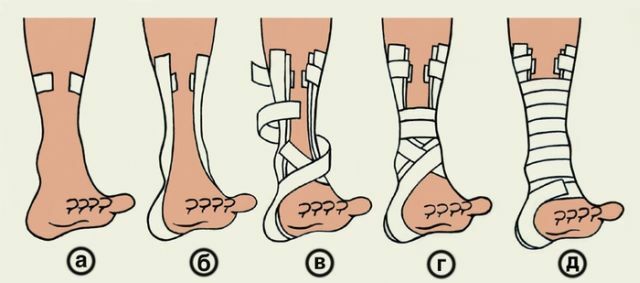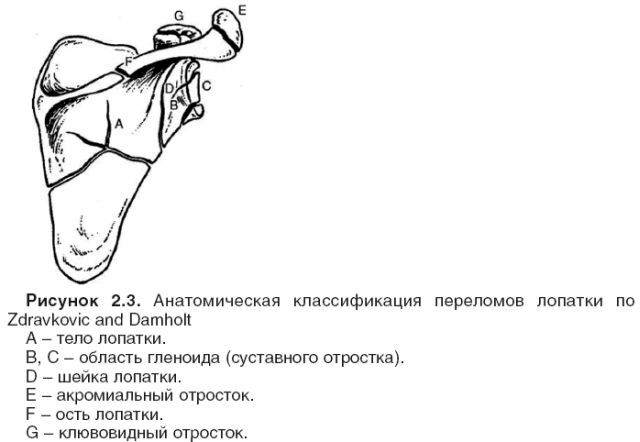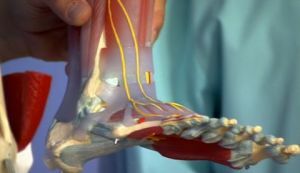 Each joint in the body has a role to play, helping us to move and perform small manipulations. The ankle joint is a joint between the ankle and the foot, secured by elastic ligaments. Thanks to the strong mechanism, the weight of the body is transferred to a certain axis, allowing us to move freely and confidently.
Each joint in the body has a role to play, helping us to move and perform small manipulations. The ankle joint is a joint between the ankle and the foot, secured by elastic ligaments. Thanks to the strong mechanism, the weight of the body is transferred to a certain axis, allowing us to move freely and confidently.
Ankle dislocation is a lesion in which the is observed to move the articular surfaces relative to each other with or without rupture of ligaments. With incomplete displacement, this state is called subluxation.
Contents of the article
- The reasons for the injury
- The classification of the dislocations
- Depending on the side of the displacement
- By the degrees of gravity
- The symptomatology that is characteristic of the
- trauma Diagnostic techniques
- The stages of treatment of the ankle injury
- Stage one. Emergency Care
- Stage two. Long-term treatment
- Traditional medicine - also an assistant
- Prevention
Causes of trauma
Injury can occur, as in carrying out household manipulation, and when practicing any sports. The main mechanisms of the injury are :
- turning the foot outward or inward;
- sharp movements of the foot when the ankle is in a fixed physiological position;
- the displacement of the foot backwards when parallel to the ground surface( for example, when the person is sharply caught by the fingers on the obstacle).
Remember, as they say in the famous movie "Fallen, woke up, plaster."Here the same picture is observed: one wrong move - an ankle dislocation. Consider situations that contribute to this type of injury :
- Sports injuries, which are associated with jogging, jumping from height, abrupt movements( athletics, parachute jumping, gymnastics, parkour, etc.).
- Careless movements that are not related to sports. Most often occur when skidding on ice and unsuccessful landing, with improper fixation of the limb during the transition to an uneven surface, when wearing shoes with high heels, or when stumbling over an obstacle with the toes.
- Situations that reduce the strength of the ankle .Elderly - the elasticity of the ligaments decreases and the muscles and diseases weaken: arthrosis, osteomyelitis, bone tuberculosis, obesity, oncological formations, etc.
Classification of dislocations
Depending on the side of the displacement
- The anterior dislocation of occurs when the lower third of the lower legfixed sole or with violent bending of the foot to the dorsal side.
- Posterior dislocation of - occurs with a strong impact on the lower third of the tibia from the front with a fixed sole or violently sharply bending the foot into the plantar side.
- External dislocation - occurs when the foot is dislocated outward and in the side, this condition is accompanied by a fracture of the lateral ankle.
- Internal dislocation of - occurs when the foot is dislocated inward, this condition can be combined with a fracture of the medial malleolus.
- Upper dislocation - occurs when falling from a height( very rare).
According to the severity of
- 1 degree - individual fiber bundles are broken;
- 2 degree - a slight ligament tearing occurs;
- 3 degree - complete detachment of the ligament from the bone to which it is attached.
Depending on the time of injury
- Fresh - less than three days have passed;
- Stale - it took about 2 weeks;
- Aged - it took more than 2 weeks, such a trauma requires open surgical correction, since during this time the surrounding tissues lost their properties, and the connective tissue proliferation occurred.
The symptomatology that is characteristic of the trauma
When a patient arrives at an appointment with a traumatologist, the patient will tell the exact time of injury, because such a condition arises abruptly and is accompanied by a complex of symptoms. 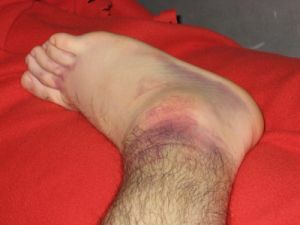 Dislocation of the ankle is accompanied by such symptoms:
Dislocation of the ankle is accompanied by such symptoms:
- Pain - on the nature of acute, increases with movement in the ankle or its palpation.
- Changing the appearance of the joint - the shape is deformed, sometimes uncharacteristic bone protrusions or palpation sensations are noticeable.
- Instability of the ankle - even with a slight subluxation, the joint is in a scrupulous state, so even a small load causes it to become dislocated.
- Ankle stiffness - if the joints are not correctly aligned, the function of the joint is impaired and the characteristic movements are not fully possible.
- Joint increase in volume - swelling of soft tissues gives a characteristic appearance of the foot: local swelling, hyperemia or damage to the vessel - bruising( sometimes hemarthrosis).
- Impossibility to exercise any movements in the joint because of increased pain. The foot acquires a forced position. There is a sharp pain when trying to stand on foot.
- Most people during dislocation may notice the characteristic crunch , which corresponds to rupture of the ligament.
- The habitual dislocation of the ankle is not accompanied by a sharp pain, but only a slight soreness in the place of injury.
The clinical picture has its own specificity depending on the degree of severity:
- 1 degree - in the ankle area there is a slight swelling, the patient complains of moderate soreness in walking, however, the function of the joint is not violated.
- 2 degree - swelling takes a large area compared to the 1st degree and, as a rule, spreads over the entire outer surface of the foot. The pain disturbs the patient not only with active walking, but also at rest. Movement in the joint is difficult.
- 3 degree - with complete rupture of the ligaments, there will be a displacement of the joint surfaces relative to each other, so the foot deforms. Edema and hemorrhages spread to the entire foot. Movement in the joint is impossible and the slightest mechanical strain provokes severe pain.
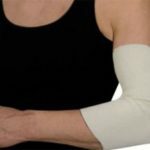 If the van caught up with such a nuisance as an elbow dislocation, then you should know how the first aid at home is.
If the van caught up with such a nuisance as an elbow dislocation, then you should know how the first aid at home is.
Consequences of subluxation of the cervical vertebra can be very deplorable if you do not diagnose the disease in time and take action. Learn how to do this here.
Diagnostic techniques
Any disease requires sequential actions, in our case they are :
- anamnesis collection - it is required to find out how the trauma( ie mechanism) occurred, the patient's main complaints and how long ago it happened. It is important to differentiate the primary and secondary dislocation, because the treatment will be different;
- objective research of - the fingers of the doctor can characterize half of the picture of any pathology, in this case, palpation will help to identify abnormal bone protrusions, assess passive joint mobility and local soreness;
- instrumental methods. Among which X-ray study of - is done to everyone with any trauma in order to clarify the degree of damage. Always pictures are taken in at least two perpendicular projections. This method helps diagnose dislocation, fracture, fracture and the degree of displacement of bone fragments. And also CT, MRI - they are resorted to to clarify the diagnosis in an obscure picture on the roentgenogram. They also use them for multiple or combined trauma, with the usual dislocations, when surgical treatment is required.
Stages of treatment of ankle injury
Ankle dislocation is a serious problem, because your further work capacity depends on the effectiveness of the care provided. Each stage of treatment with an ankle dislocation involves certain actions that are required at this particular time. There are three main stages of treatment for .
Stage one. Emergency assistance
It turns out in the first 48 hours. So, what to do with ankle dislocation in the first minutes after injury :
- Ensure the calmness of the limb - remove any mechanical impact, remove the shoes.
- Apply cold - will help reduce swelling and pain. Ice wrap the towel and apply for 15 minutes, then repeat the procedure in an hour.
- Immobilize the limb - fix the limb in the position in which the joint is located( if possible, grab the knee joint).You can use improvised tools, such as a ruler, which will find application instead of functional tires.
- Give the elevated position of the limb - due to the reduction in blood stagnation in the vessels, the swelling of the limb will not increase.

In the photo the step-by-step instruction on the dressing application with the dislocation of the ankle
Stage two. Long-term treatment
Treatment of ankle dislocation in the second stage differs depending on severity .
- 1 degree. Dislocation of the dislocation, the imposition of an eight-part bandage for 2-3 days. After removal of the dressing, warming compresses, physiotherapy, and exercise therapy are prescribed.
- 2 degree. Direction of dislocation, application of U-shaped gypsum tape for 12 days, physiotherapy, massage and physiotherapy exercises( for the time of the procedures the bandage is removed).The rehabilitation period is 3 weeks.
- 3 degree. Dislocation of the dislocation. With hemarthrosis, a puncture is indicated. Then applying a plaster bandage for a period of 1 month( from the fingertips to the upper third of the shin).Possible introduction of novocain in the joint area. Carrying out physiotherapy, massage and physiotherapy. After removing the gypsum, it is required to wear a fixing bandage for 1.5-2 months. And the total recovery time after ankle dislocation can take up to three months
Thus, it is possible to quickly cure an ankle dislocation only at the first and second degrees of the complexity of the injury.
Traditional medicine is also an assistant to
- Alcohol packs - moisten a napkin in alcohol solution, put on a damaged limb, wrap in cellophane and put on a sock( do overnight).
- Solution ½ tablespoon salt + 125 ml table vinegar , moisten the napkin and do as in the first case.
- Prepare the infusion of herbs : calendula, string, celandine and tansy. Pour the flowers with boiling water, let it brew for 40 minutes. Dampen the napkin and attach to the joint, after drying, repeat the procedure.
- Compresses with urine - dip the napkin into the urine, and repeat the procedure from the first paragraph.
Prevention
- remove heels from the wardrobe;
- strengthen joints and muscles;
- lose weight;
- Avoid unwary movements;
- protect joints( elastic bandaging).

